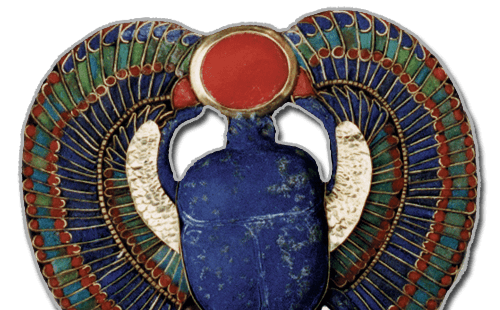DNA identifies Tutankhamun's parents
Ever since the pharaoh Tutankhamun was discovered in his tomb in 1922 by the British archaeologist Howard Carter debate has raged as to his real identity. In recent years the advance in DNA profiling has given hope that Tut's family connections could possibly be revealed.
The results of important DNA tests carried out in Egypt announced today have now identified Tutankhamun's parents, but who are they? The mystery parents have been identified but have yet to be positively named by conventional archaeological means.
At a momentous press conference held in Cairo this morning the 17th February Dr Zahi Hawass, head of Egypt's Supreme Council of Antiquities announced the results of DNA tests on Tut's mummy carried out by a team of Egyptian scientists from the National Research Centre, Cairo University's Faculty of Medicine and two German DNA specialists on behalf, of the Egyptian Mummy Project headed by Hawass.
Published in the Journal of the American Medical Association the results have produced a possible family tree that suggests that Tutankhamun was the son of the anonymous mummy in tomb KV55 in the Valley of the Kings. His mother, also anonymous, was possibly buried in tomb KV35. Through the DNA testing of a group of other royal mummies it suggests that Tut's Grandparents were the pharaoh Amenhotep (Amenophis) III and his queen Tiye. Tutankhamun's great grand parents were Yuya and Thuya whose mummies were found in tomb KV46 in the Valley of the Kings.
Unfortunately as the mummies in KV55 and KV35 have not been positively identified by conventional archaeological means, they can only be identified by "reverse engineering", which may suggest that Tutankhamun's father was the heretic pharaoh Akhenaten. But while it may be possible to link Tutankhamun with the mummy in KV55 by DNA it is still not possible to be certain of the identity of the mummy. So some of the mystery still remains.
Another uncertainty is the parentage of the remains of foetus 1 and foetus 2 buried in Tutankhamun's tomb. Only partial data was able to be recovered and a attempt to produce a sequence was not successful. The identity of their possible mother buried in tomb KV21 also remains a mystery for the same reason.
Staff at the Tutankhamun Exhibition on view in Dorchester have been eagerly awaiting the results of these momentous tests carried out on the mummy of Tutankhamun and other royal mummies.
Tim Batty, general manager of the Tutankhamun Exhibition said " We have been preparing to display the results of the DNA tests in a special display at the exhibition in Dorchester as soon as they were announced. It's another piece of the great jigsaw surrounding the life and death of Tutankhamun. We are sure the public will find it enthralling".
He continued "In addition to genetic information on Tut's family connections the DNA tests have reveal further information such as diseases and inherited problems that may have afflicted Tutankhamun. The tests show that Tutankhamun was infected with Malaria that may have killed him. But it is also possible that he may have been infected but not to a degree that caused his death. For good measure the tests on his great grand parents Yuya and Thuya show that they too were infected with Malaria. The Malaria just adds to the many possible causes of his death."
The results of the DNA tests will be on display at The Tutankhamun Exhibition in Dorchester from Thursday, 18th February.
Background to the tests
The results of the DNA tests were hoped by many to settle exactly how Tutankhamun fits into the picture of the Egyptian 18th Dynasty family tree.
The fact that the tests have been carried out at all is a welcome U turn by Dr Zahi Hawass who has in the past treated the idea of DNA testing with scepticism. Hawass is reported as saying "From what I understand, it is not always accurate and it cannot always be done with complete success when dealing with mummies. Until we know for sure that it is accurate, we will not use it in our research"
In December 2000 a team from Cairo's Ein Shams University and Waseda University in Japan were given permission to take tissue samples. However the Egyptian Government withdrew permission at the last moment. The Supreme Council of Antiquities turned down the tests on the grounds that it was unlikely to produce results and it could damage the already fragile mummy. Hawass is on record as saying that DNA analysis would not lead to anything and therefore the tests were out of the question.
In 2003, Professor Scott Woodward, a microbiologist from Brigham Young University (USA) who had previously carried out DNA on a group of 27 royal mummies at the Cairo Museum was asked to carry out the DNA tests but then again the Egyptian Government rescinded on the grounds of "national security".
The chances of establishing a successful DNA sequence for a mummy are not good. Professor Woodward who carried out tests on 27 royal mummies was only able to establish 12 successful sequences.
In the results of the DNA tests announced today 3 sequences could not be established, foetus 1 and 2 and the mummy in tomb KV21 thought to be their mother. Tutankhamun's link as possible father can at present not be fully established.
The condition and treatment of the body during mummification may have a bearing on successful. DNA is fragile easily decomposes, breaking the strands of DNA into fragments, which can result in false sequencing.
Published: 15th Jan




.jpg?w=1960&h=496&zc=1)
.jpg?w=351&h=144&zc=1)
.jpg?w=351&h=144&zc=1)
.jpg?w=351&h=144&zc=1)


